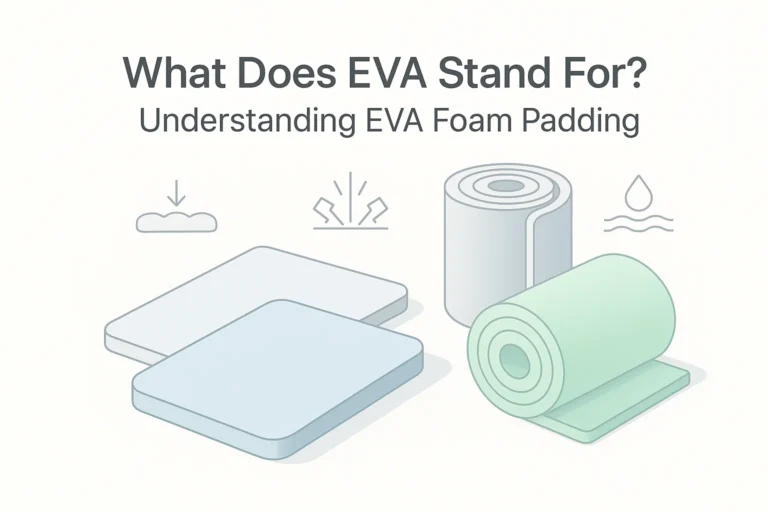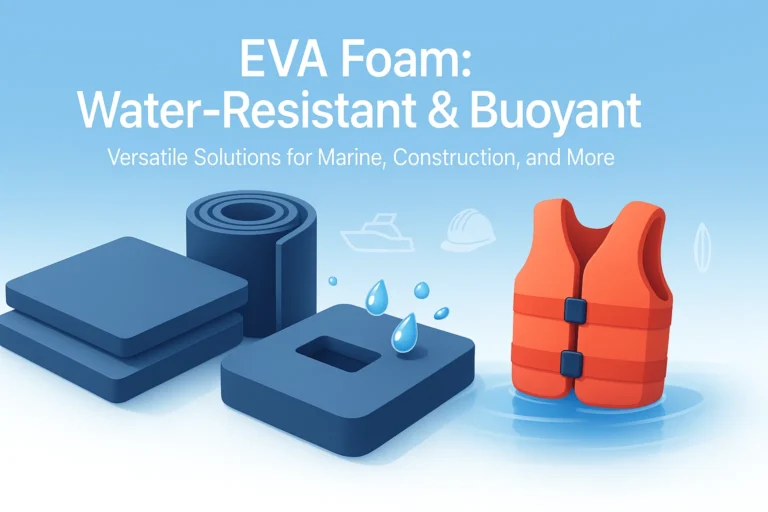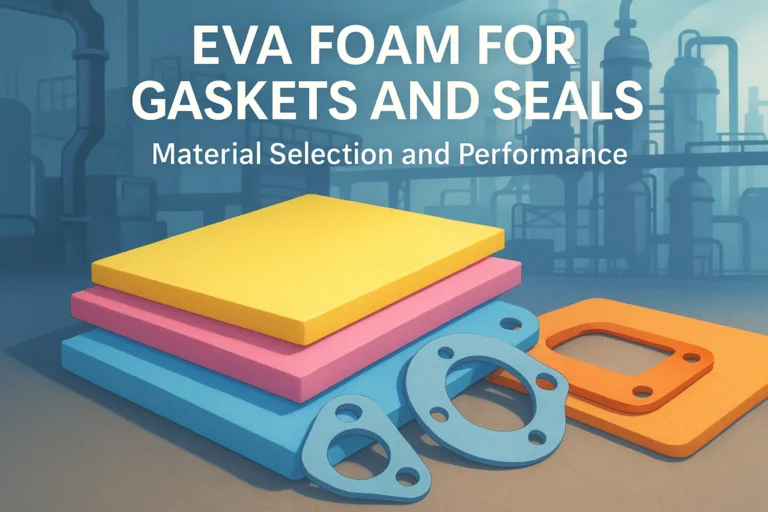¿Qué es exactamente la espuma EVA? Su guía completa sobre este versátil material
¿Qué es exactamente la espuma EVA? Su guía completa sobre este versátil material
¿Alguna vez has rebotado en una suave alfombrilla de juegos, te has calzado unas cómodas chanclas o te han maravillado los intrincados detalles de una armadura de cosplay? Lo más probable es que se haya encontrado con la espuma EVA. Este extraordinario material se ha infiltrado silenciosamente en numerosos aspectos de nuestra vida cotidiana y aficiones especializadas. Pero, ¿qué es exactamente la espuma EVA? Exploremos este material versátil y fascinante.
Desembalaje del nombre: ¿Qué significa EVA?
EVA significa Etileno-acetato de vinilo. Es un copolímero, lo que significa que está hecho de dos monómeros diferentes (etileno y acetato de vinilo) unidos químicamente. Es como una receta en la que el etileno aporta dureza y flexibilidad, mientras que el acetato de vinilo aporta suavidad y elasticidad. La proporción de estos dos componentes puede variar durante la fabricación, lo que da lugar a una amplia gama de tipos de espuma EVA con diferentes propiedades.
La ciencia detrás del aplastamiento: Propiedades de la espuma EVA
La espuma EVA posee una impresionante variedad de propiedades que la hacen muy útil en diversas aplicaciones. Estas son algunas de sus principales características:
- Suavidad y flexibilidad: Quizá sea ésta su característica más conocida. La espuma EVA puede ser desde muy suave y blanda hasta semirrígida, dependiendo de su densidad y composición.
- Ligero: A pesar de su resistencia, la espuma EVA es increíblemente ligera, lo que la hace ideal para productos en los que el peso es un problema (por ejemplo, esterillas de yoga o acolchado para mochilas).
- Excelente absorción de impactos: Es fantástico para amortiguar impactos, por lo que es un material muy utilizado en equipos de protección, suelas de zapatos y superficies de parques infantiles.
- Resistencia al agua: La espuma EVA es una espuma de célula cerrada, lo que significa que sus células no están interconectadas. Esta estructura la hace muy resistente al agua y a la absorción de humedad.
- Durabilidad: Puede soportar tensiones y flexiones repetidas sin desgarrarse ni romperse fácilmente.
- Buen aislamiento térmico: Proporciona cierto grado de aislamiento contra el calor y el frío.
- Resistencia química: La espuma EVA es resistente a muchos productos químicos, aceites y grasas comunes.
- No tóxico (en general): La mayoría de las fórmulas de espuma EVA se consideran no tóxicas y seguras para los productos de consumo, aunque siempre es bueno comprobar las certificaciones específicas, especialmente en el caso de los juguetes infantiles.
- Fácil de trabajar: Se puede cortar, moldear y pegar con facilidad, lo que lo convierte en el favorito de artesanos, cosplayers y fabricantes.
- Colores vibrantes: La espuma EVA puede fabricarse en una amplia gama de colores brillantes y uniformes.
¿Cómo se fabrica la espuma EVA? Un vistazo al proceso
La producción de espuma EVA suele constar de unos pocos pasos clave:
- Mezclar los ingredientes: Se mezclan etileno, acetato de vinilo, agentes espumantes (sustancias químicas que crean las células de espuma), pigmentos de color y otros aditivos.
- Extrusión o moldeo:
- Extrusión: La mezcla se calienta y se hace pasar por una matriz para crear láminas o perfiles continuos.
- Moldeo (moldeo por compresión): La mezcla se coloca en un molde de una forma específica.
- Expansión (formación de espuma): Los agentes espumantes se descomponen con el calor, liberando gases que crean pequeñas burbujas o células dentro del material, haciendo que se expanda en una estructura de espuma.
- Curado/enfriamiento: A continuación, el material espumado se cura (a menudo con más calentamiento) y se enfría para estabilizar su forma y propiedades.
- Acabado: A continuación, la espuma puede cortarse en láminas de distintos grosores, pelarse, laminarse con otros materiales o someterse a otros procesos (por ejemplo, troquelado o termoformado).
¿Dónde vemos la espuma EVA? Un mundo de aplicaciones
La versatilidad de la espuma EVA hace que aparezca en un número asombroso de lugares. He aquí algunos ejemplos:
- Calzado: Entresuelas, plantillas y suelas de zapatillas, sandalias, chanclas y botas. Su amortiguación y ligereza son perfectas para un calzado cómodo.
- Deportes y ocio: Esterillas de yoga, colchonetas de gimnasia, protectores (cascos, espinilleras), flotadores de piscina, tablas de surf y defensas de barco.
- Juguetes y manualidades: Alfombras de juego para niños, piezas de rompecabezas, hojas de manualidades para proyectos de bricolaje y, por su facilidad para moldear y pintar, disfraces y accesorios de cosplay.
- Embalaje: Insertos de protección para productos electrónicos, frágiles y equipos médicos gracias a su excelente absorción de impactos.
- Automóvil: Acolchado interior, juntas y sellos.
- Construcción: Juntas de dilatación, contrapisos para suelos y aislamiento.
- Electrónica: Fundas para tabletas y teléfonos, alfombrillas de ratón.
- Sanidad: Soportes ortopédicos, aparatos ortopédicos y componentes de dispositivos médicos.
Espuma EVA: Ventajas y consideraciones
Como cualquier material, la espuma EVA tiene sus pros y sus contras:
Ventajas:
- Excelente amortiguación y absorción de impactos
- Ligero y flexible
- Resistente al agua
- Duradero y resistente
- Fácil de fabricar y personalizar
- Disponible en una amplia gama de colores y densidades
- Generalmente no tóxico
Posibles consideraciones:
- Olor: Algunos productos de espuma EVA pueden tener un olor característico cuando son nuevos, a menudo descrito como ligeramente dulce o químico. Este olor suele desaparecer con el tiempo.
- Degradación UV: La exposición prolongada a la luz solar directa puede hacer que algunos tipos de espuma EVA se degraden o se vuelvan quebradizos con el tiempo, aunque se pueden añadir estabilizadores de UV durante la fabricación.
- Impacto medioambiental: Aunque parte de la espuma EVA puede reciclarse, no todos los programas de reciclaje la aceptan. Los materiales de base son derivados del petróleo. Sin embargo, se están haciendo avances en las alternativas de EVA de base biológica.
- Sensibilidad a la temperatura: Las temperaturas extremadamente altas pueden provocar la deformación de la espuma EVA.
Cómo elegir la espuma EVA adecuada
Con tantas variantes, ¿cómo saber qué espuma EVA se adapta mejor a sus necesidades? Tenga en cuenta estos factores:
- Densidad: La espuma de mayor densidad suele ser más firme y duradera. Las de menor densidad son más blandas y flexibles.
- Dureza: Medido en una escala Shore (por ejemplo, Shore A o Shore C), indica la resistencia de la espuma a la indentación.
- Grosor: Determina el nivel de amortiguación y rigidez.
- Estructura celular: La mayor parte del EVA es de célula cerrada, pero es bueno confirmarlo para aplicaciones que requieran resistencia al agua.
- Propiedades especiales: ¿Necesita resistencia a los rayos UV, ignífugos o colores específicos?
El futuro de la espuma EVA
La espuma EVA sigue evolucionando. Investigadores y fabricantes están explorando:
- Espumas EVA más sostenibles y de base biológica: Reducción de la dependencia de los combustibles fósiles.
- Propiedades mejoradas: Absorción de impactos, durabilidad o resistencias específicas aún mejores.
- Nuevos métodos de reciclado: Mejora de la economía circular de los productos de EVA.
Espuma EVA: Más que espuma
La espuma EVA es un material realmente extraordinario, que protege los pies y permite una creatividad increíble. Su combinación única de suavidad, ligereza y resistencia ha consolidado su lugar en innumerables industrias y aficiones. Así, la próxima vez que te encuentres con ese material colorido y blandito, sabrás exactamente qué es la espuma EVA y apreciarás la ciencia y la versatilidad que encierran sus diminutas células.







